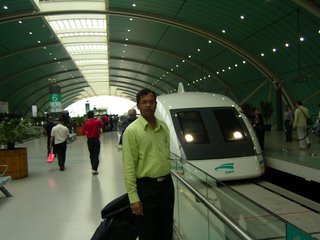Stephen Roach brings out the fact that the contrast between the Indian & Chinese approaches is dramatic. The industry share of Chinese GDP has gone from 42% to 47% over the past 15 years - maintaining a huge gap over India’s generally stagnant 28% manufacturing share over the same period. By contrast, the services share of Indian GDP has risen from 41% in 1990 to 54% in 2005 - well in excess of the lagging performance in Chinese services, which has gone from 31% of GDP in 1990 to 40% in 2005.
 China’s macro character fits its manufacturing-led growth dynamic to a tee. Exports and fixed investment now account for over 75% of China’s GDP - and are still growing at close to a 30% rate today.
China’s macro character fits its manufacturing-led growth dynamic to a tee. Exports and fixed investment now account for over 75% of China’s GDP - and are still growing at close to a 30% rate today.
India currently has over 25 world-class companies, well-developed capital markets, a modern banking system, and a deeply entrenched rule of law. China is lacking in all of those key respects, and very much wants to move in those directions. China is also seeking to implement an Indian-style expansion of labor-intensive services in an effort to provide the job and income support to its nascent consumer sector. However, given the high degree of precautionary saving sparked by the massive layoffs arising from state-owned enterprise reforms, China may well encounter considerable difficulty in establishing a broad-based consumer culture. At the same time, India very much aspires to match China’s progress on the manufacturing front. India’s political leadership is convinced that manufacturing is the answer to high unemployment in impoverished rural areas.

China and India represent the future of Asia - and quite possibly the future for the global economy. Yet both economies now need to fine-tune their development strategies by expanding their economic power bases. If these mid-course corrections are well executed - and there is good reason to believe that will be the case - China and India should play an increasingly powerful role in driving the global growth dynamic for years to come. With that role, however, come equally important consequences. IT-enabled globalization has introduced an unexpected complication into the process - a time compression of economic development that has caught the rich industrial world by surprise. Out of that surprise comes a heightened sense of economic security that has stoked an increasingly dangerous protectionist backlash. This could well pose yet another major challenge to China and India - learning how to live with the consequences of their successes.
As I see it, while, India is trying to imitate the chinese model, I would like to point out that while all these make interesting reading, what’s generally overlooked in discussions about china is the enormous pollution that I noticed in China during my recent visit. Some alarming data:
- State estimates suggest that china’s pollution is 12 times the world average.
- The sulphur dioxide emission is 22.5 million tones as against 12 million tonne carrying capacity
- Two-Fifths of the seven major river basins are polluted
- Ninety percent of rivers passing through cities are fully polluted
- Three hundred million residents have no access to purified water
- One-Third of chinese territory suffers from acid rain
- Two-thirds of the population suffer from poor air quality
- Inestimable number of potential cancer patients(mostly young) in the country
In fact Morgan Stanley’s best china watcher Andy Xie writes that china’s environment catastrophe is poorly understood. He points out that if the relocated factries had to subscribe to the same environmental standards as in the OECD countries, goods made in china may not be that cheap and adds that the lesser costs for pollution have been important than cheap labour in the deflationary pressure from china. Cleary India would have to chart its own balanced model of growth rather than blindly imitating the chinese growth formula.
Category :Chindia, Development Models
|

